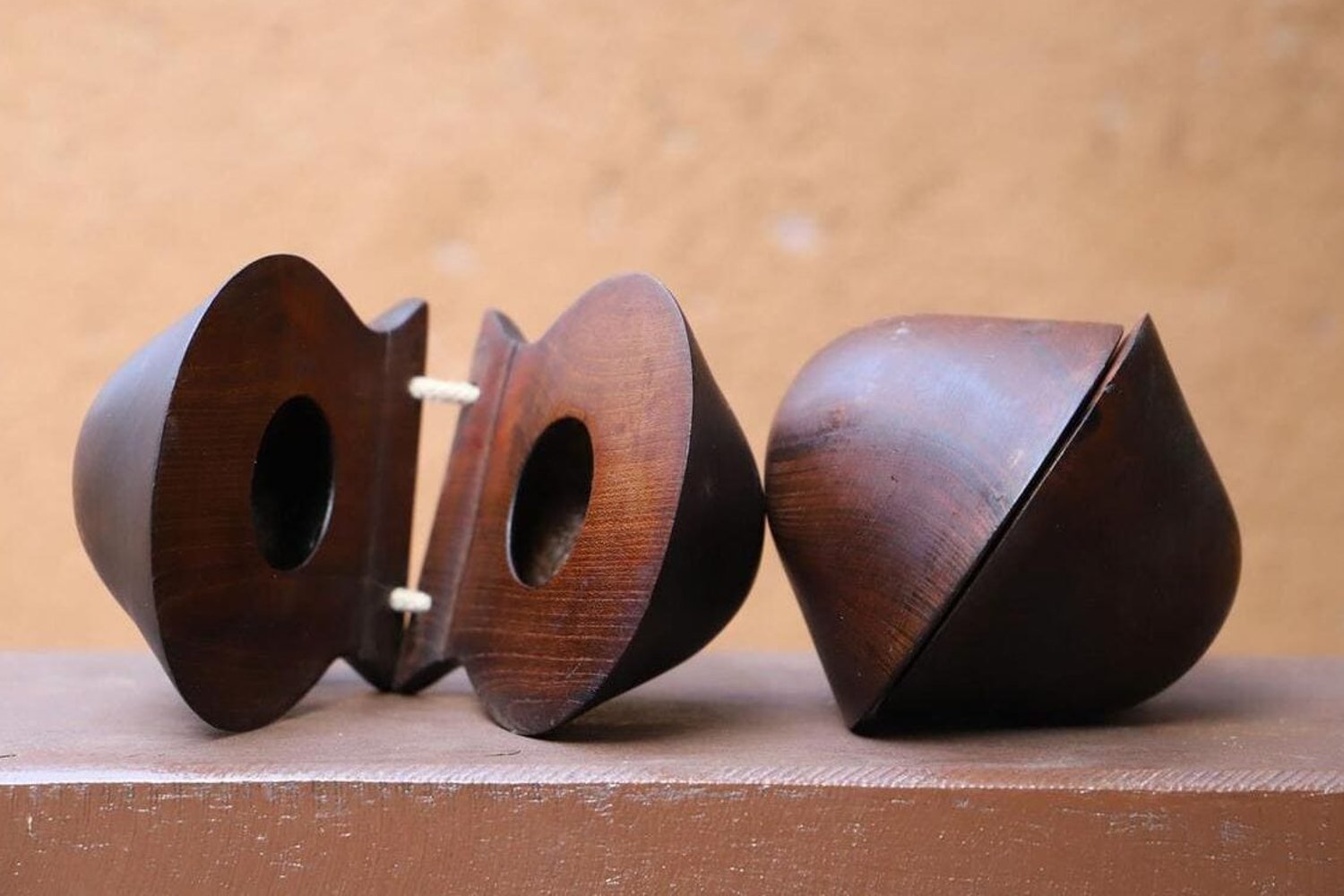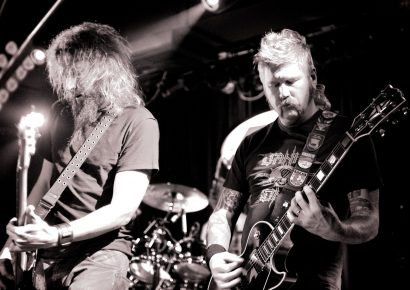Musicians have been using all kinds of daffy effects to add to their percussion arsenal.
Famous percussion includes a spinning ashtray on The Pretty Things’ “Cold Stone”, pool balls on R.E.M.’s “Murmur”, biscuit tins on XTC’s “The Big Express” and a Kleenex box on Fleetwood Mac’s “Tusk”. There’s also spoons in a different pitch on Soundgarden’s “Spoon Man” and a combination of glass ashtray & Coke bottle by The Beach Boys on the Beach Boys’ Party! and The Dixie Cups on “Iko Iko”.
Musicians have been using all kinds of daffy effects to add to their percussion arsenal.
Read all our latest features and gear columns here.
Or they use “proper” non-western percussion and instruments, like the African djembe (Sepultura’s “Roots Bloody Roots”), Brazilian cuica (Bob Marley and The Wailers’ “Could You Be Loved”, Paul Simon’s “Me And Julio Down by the Schoolyard”) and Indian tabla (Bela Fleck’s Live At The Quick and The Beatles’ “Within You Without You”, “Tomorrow Never Knows”).
Percussion Instruments
Japanese small single-head octobans (“tube toms”) grouped in square patterns as melodically-tuned sets of eight, have their fans including Stewart Copeland during his Police days, early adopter Billy Cobham, Bill Bruford, Joey Jordison, Dave Lombardo, Mick Fleetwood, Roger Taylor of Duran Duran, Steve Jansen of the band Japan, and Chad Smith.
As for cowbells, cowbellsongs.com lists a thousand songs featuring Bossy’s ring, including Rage Against the Machine’s “Killing In The Name”, The Rolling Stones’ “Honky Tonk Women”, Fu Manchu’s “Mongoose” and Blue Oyster Cult’s “Don’t Fear The Reaper”.
Here are 15 exotic percussion instruments to consider putting a bit of spice in your sound.
1. Aburukuwa (Ghana)
The Aburukuwa (a.k.a. the Abrukwa) is a bottle-shaped open drum with pegs holding in its skin. It’s played with curved stick, with its high pitched penetrating sound resembling a birdsong.
It is played by the Akan and Asante people of Ghana at mostly funerals and ancestor worship, with red and black felt representing death and blood. It is the smallest of the three drums used in these ceremonies, and hence has a support role, playing the same rhythm that intertwines with the other two.
2. Apito (Brazil)
Apito, the Portuguese word for “whistle”, refers to a number of whistles, with different functions, and which are made of wood, copper or plastic.
Both sides have openings. By plugging one with the thumb and forefinger, the player gets a second higher pitched note. It adds to the piece’s polyrhythms.
The LP Tri-Tone Samba Whistle, a standard today in dance music, has three distinct precision tones. This is achieved by placing fingers over the side chamber holes in various combinations. But the samba apito, used on samba workouts, is used in Brazil by the bandleader to signal changes, along with his hands, to tempo, rhythmic pattern or timbre.
3. Chácaras (Canary Islands)
A larger wood and bone version of the castanets with a hollow body, chácaras are notably used in traditional music of Hierro and La Gomera, two of the seven islands making up the Canary Islands.
The handcrafted chácaras are often used in music and dancing events with the five-string plucked string timple, pito herreño whistle and local drums. Like castanets, their sound varies depending on what they’re made of, their tuning, their size, and the way they’re played.
The macho (male) chácara, with a deeper sound, is held in the left hand and sets the rhythm. The hembra (female) in the right hand, provides chimes.
4. Dhol (India)
The Dhol, derived from the Sanskrit word ‘dhola’ for drum, is a double-sided barrel drum played with two wooden sticks of different shapes. It is of varying size and make-up through different parts of India, and used for everything from spiritual and folk events to Bollywood and bhangra [traditional folk] dances.
It is usually played slung over the shoulder, the skin stretched over its open ends, which are stretched or loosened with a tightening mechanism made of interlinked ropes or nuts and bolts, to alter its pitch.
5. Kenong (Indonesia)
The gamelan, the indigenous orchestra of Java and Bali, accompanies theatrical performances and wayangs (puppet theatre).
It uses a series of gongs suspended or placed flat, and various percussive metal instruments struck with mallets, with a sustained melody carried by the bamboo flute or a bowed stringed instrument or sung.
The kenong is the loudest, largest and most distinctive of the gongs, placed on its side, with sticks taller than that of the bonang’s kettle-shaped gongs.
6. Ikoro (Nigeria)
The ikoro is a massive slit drum used by the Igbo communities of Southeast Nigeria. Measuring about 9 feet in diameter and 8 feet long, a ladder is needed to get to the top of the instrument to play it with sticks. Because of its weight, it is just left in one place, usually the town square.
Traditionally played by males, its thundering sound was used as a war drum or coded message to other tribes.
7. Shōko (Japan)
The small bronze gong from the 10th century is suspended in a decorative lacquered vertical frame, comes in three sizes, and struck with two mallets.
It is used at gagaku (“elegant music”), a classical music originally used in palace music and dances, and later folk poetry and foreign music.
8. Makuta (Cuba)
Brought to western Cuba by slaves from Central Africa (Bantu or Congo), they were originally set up as two drums. But they’re more recently used up to four to drive a greater array of dance rhythms. Usually a meter high and the goat-skin heads about 30—49 cm in diameter, the larger drum is barrel-shaped with tensioning metal rods, while the smaller one is cylindrical.
They are played standing, with the lead drummer additionally wearing shakers on his wrists. When used by western drummers, these shakers are usually blended with cymbals, and provide a better balance to bass and kick tones.
9. Bodhrán (Ireland)
The ancient Irish circular frame drum has already found an audience in Australia through its use in Celtic and world music ensembles.
But innovators as The Boys of the Lough’s Robin Morton, The Chieftains’ Peadar Mercier, Planxty’s Christy Moore, and De Dannan’s Johnny “Ringo” McDonagh have showcased a wider use and sounds, and an instrument that can be easily personalised for other styles of music.
Usually played in a seated position and often called “a poor man’s tambourine”, it is a goatskin (usually) head tacked to one side, with the other side open-ended for one hand to be placed against the inside of the drum head to control the pitch and timbre.
They can get different sounds because they come from different sizes, have many striking techniques, utilise many rhythms and the recent “top end” style allows for enough different pitches for the player to follow the tune, and given it a greater global appeal.
10. Jawbone (Latin America)
For a loud abrasive rattle sound with multi-rhythms to drive a performance, try the quijada or charrasca, or jawbone in English.
It is made from the jawbone of a donkey, horse, mule, or cattle, and dried to loosen the teeth so they rattle. A stick can strike the teeth or pulled along them, providing a distinctive sound.
Brought from Africa during colonial days, the quijada is traditionally used in Peru and Cuba. But it has been widely adapted through Latin America, often used with the marimba (xylophone) in Costa Rica, Mexico, Nicaragua, Honduras and Guatemala.
Animal jawbones are not readily available in most Australian suburbs. So an option is egg cartons tied with packing tape, and filled with pebbles, dried pasta, buttons, coins, beads, seashells or pine cones.
11. Ferrinho (Cape Verde)
A 90-metre metal bar it is most associated with funaná, a style of music from the Cape Verde islands of west Africa. It is scraped by another metal instrument in up-and-down movements while the top end rests on the player’s shoulder.
It can be showcased solo or usually it’s accompanied by the gaita (accordion) and sometimes by the directly-struck triangle.
12. Dayereh (Iran/Persia)
The dayereh (also spelled “dayere”) is a medium-sized percussion drum performed in Persian folk, classical and street performances – and more in pop music.
Its circular wooden and ivory frame is covered in part by the thin skin of a baby goat, and bronze clapper bells, coins and metal caps attached.
It is held upright in the left palm, with three fingers tapping the head, with the fingers, palm, and fist of the right hand also used. The elbow, shoulder, and knee are also utilised.
13. Babendil (Philippines)
The narrow-rimmed bronze gong, hung on a frame stand, provides a distinctive sharp metallic clang from being struck on the rim with a bamboo stick or cane strip from the seated position.
It is the main time keeper of a row of four small, horizontally laid gongs providing melody and chimes called kulintang.
14. Bubon (Ukraine)
The Ukrainian tambourine has a diameter of 50 centimetres over a dog’s skin, with brass rings to provide the rattle with struck by hand or stick.
It dates back to the 11th century and was also a popular percussion instrument among the Ukrainian Cossacks.
15. Ganzá (Brazil)
The ganzás are cylindrically shaped metal or handwoven basket shakers filled with beads, metal balls and pebbles. They are used as timekeepers of a percussion ensemble with the different sounds of tan-tan, rebolo, repique de mão and tamborim.
As with any folk instrument, they’re popular in social situations as beach parties or bar sessions or concert with samba and reggae. Two can be connected by a single bar for greater noise.
They can be both loud and soft depending on the music they accompany.
Under master percussion players, the ganzás show off the sheer complexities of multicultural Brazilian music, whether the smoother sophisticated bossa nova or the more frantic samba, or the way they can play cross-sticks to imitate a snare and tamborim drum.

